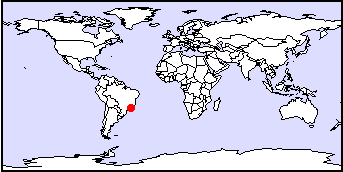 |
 |
||||||||||
| |||||||||||
 |
 |
||||||||||
| |||||||||||
The city of Rio de Janeiro (a.k.a. Rio), a world wide known tourist, industrial and commercial center is a 5,5 million inhabitants metropolis, in addition to approximately four millions living in the suburbs around the town. The municipality of Rio has an area of about 1000 km2, which reaches about 5000 km2 if metropolitan area is included. It is located around parallel 43W and meridian 23S, along Brazilian Atlantic shoreline. Its vegetative pop. growth amounts to 1.5% and the economic growth is of 5% per year (1994 data, approximate). It has a diversified industrial area. Rio is an important cultural center with many museums, theaters and art galleries of international quality.
The climate is tropical wet, with humid and moderately hot summers (70% of rainfall concentrated between December and March) and mild to fresh dry winters. The annual rainfall has a great variation due to its rugged topography, ranging from 1200 to 2500 mm/yr. There is a high evapotranspiration but little or no deficit along the year.
The geology of Rio comprehends igneous and metamorphic suites of Precambrian ages, constituted by migmatites, gneiss's granites, with very complex estratigraphic relationships and tectonic settings. It is normally regarded as a "cristaline bedrock" that is a very poor aquifer, unless faults and diabase dikes occur. Filling the coastal plains, arealy important in the west and north parts of the town, sequences of Quaternary and Tertiary sediments occur. They are formed by clayey to sandy horizontal unconsolidated layers. These sediments can be important aquifers, used by low rent people who live in the peripheral areas of the town, through the excavation of hand dug shallow wells.
The eater supply in Rio is almost entirely provided by surface sources, with an average discharge of 40 m3/s. The use is almost entirely for public domestic supply and industries. There is a couple of large sewage treatment stations, which can only account for approximately 30% of the sewage of the city. The rest of it is thrown some km away from the coast by a pipeline "in natura" or simply discharged at Guanabara Bay. The bay is actually heavily polluted by domestic and industrial waste.
No information.
The main problems concerning groundwater in Rio are those related to the use of contamined water in shallow wells in poor peripheral zones, a problem that diminishes with the increasing extension of the official surface distribution net; the slow flow of industrial pollutants to the Guanabara Bay, presently undertaking a despolluction plan with Japanese technical support; and mainly the serious and sometimes fatal geotechnical problems - landslides - arising from the percolation of groundwater in the densely populated slopes of the city, especially during the summer season.
The public concern is high, and there are several projects under way, carried out by official and private institutions, such as: - FEEMA - Fundacao Estadual do Meio Ambiente - Fundacao Geotecnica - Geol. Ricardo d'Orsi - CEDAE - Cia. Estadual de Aguas e Esgotos - Geol. Egmon Pereira
No information.
FEEMA - Fundacao Estadual do Meio Ambiente - Phone: +55-21-2542038 or 5809223 Fundacao Geotecnica - Geol. Ricardo d'Orsi - Phone: +55-21-5895757 - FAX: +55-21-5894016 CEDAE - Cia. Estadual de Aguas e Esgotos - Geol. Egmon Pereira - Phone: +55-21-7222538